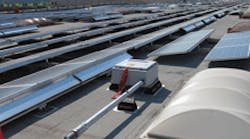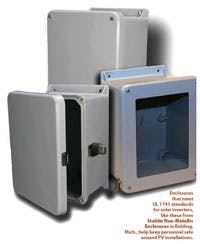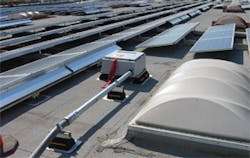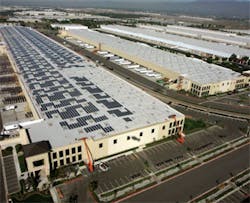Enclosures help keep solar-energy projects safe
Authored by: |
The National Fire Protection Association (NFPA) consistently ranks electrical fires as among the top five most-frequent types of fires in commercial buildings. Electrical fires also tend to produce a higher percentage of property damage than other sources of combustion.
Unfortunately, solar panels can become an ignition source for building fires. Arc-faults pose the greatest fire risk to photovoltaic (PV) installations. The need to detect and extinguish arc-faults in PV systems has given birth to a new protection device called a DC PV Arc-Fault Circuit Interrupter (DC PV AFCI). Designed to detect the signature of an arc-fault in the power line it monitors, the DC PV AFCI kills the current flowing through the line upon detecting an arc-fault condition.
If a fire should start, controlling its spread becomes paramount in limiting the damage it causes. Obviously, the selection of materials used in the construction of the PV system and, of course, its enclosure, plays a critical role in controlling a fire’s spread. Fire testing programs carried out by Underwriters Laboratories (UL), the NFPA, and other facilities play a key role in understanding how a material reacts when it burns.
Plastic materials undergo two flammability tests to measure their burning qualities. The first test, outlined in UL 94, determines a material’s tendency either to extinguish or spread the flame once ignited. While UL 94 sets standards for the U. S., it complies with international standards IEC 60707, 60695-11-10, and 60695-11-20 along with ISO 9772 and 9773.
The second test program measures the ignition resistance of the plastic to electrical-ignition sources. Material resistance to ignition and surface tracking is described in UL 746A, which also complies to the test procedures described in IEC 60112, 60695, and 60950.
UL flame ratings group materials into categories based on their flammability. UL 94 looks at how the materials burn in both vertical and horizontal positions.
For the horizontal test a specimen supported in a horizontal position is tilted 45°. The specimen contains two marks, one at 1 in. from the burn edge and another at 4 in. A flame is applied to the end of the specimen for 30 sec or until the flame reaches the 1-in. mark. If the specimen continues to burn after the removal of the flame, the time needed to burn between the 1 and 4-in. marks is recorded. If the specimen stops burning before the flame spreads to the 4-in. mark, the time of combustion and damaged length between the two marks is recorded. Three specimens are tested for each thickness of the material.
Vertical testing takes place on both bar and plaque, basically a flat sheet, versions of the material under test. The bar is supported in a vertical position, typically by hanging it from overhead. The flame is applied for five seconds to one of the lower corners of the specimen at a 20° angle. It is then removed for 5 sec. Flame application and removal is repeated five times.
Plaques are tested the same as bars except the plaque mounts horizontally and the flame is applied to the center of its lower surface.
Flame ratings for plastic materials commonly used to mold enclosures, structural parts, and insulators found in consumer electronic products receive a rating of 5VA, 5VB, V-0, V-1, V-2, or HB. Material rated as 5VA or 5VB provides the best protection against fires in that it is subjected to a flame-ignition source approximately five times more severe than that used for the other ratings.
Keeping up to date
Electrical codes are updated periodically, and those that apply to PV installations are constantly changing and evolving. Some important new developments happening in the solar industry include a grant awarded to UL to study firefighter safety around photovoltaic systems. The grant funds a project that addresses first-responder concerns about fighting fires involving PV modules. This research project investigates firefighter vulnerability to electrical and casualty hazards when fighting a fire involving PV modules and support systems in residential and commercial buildings.
PV use is growing at a rate of 30% annually in the U. S. This new technology complicates traditional firefighter tactics, leaving firefighters vulnerable to severe hazards including burns and electrical shock. Although the electrical and fire hazards of PV systems are addressed through current product standards and certification, only a limited body of knowledge with scant data exists for fire services to develop the safe tactics needed during fire-suppression and ventilation activities.
Standards bodies are evaluating the hazards associated with PV systems in firefighting operations through experimental methods based on UL’s expertise in product testing and standards development. The experiments develop empirical data that helps understand the type and magnitude of the hazards firefighters face with PV systems. New firefighting methods that come from this research must deal with electrical principals, fire dynamics, and the adaptation of existing firefighting tactics.
Individual states formulate their own rules for safety codes. Oregon, for example, is drafting a solar-energy code that establishes fire-safety measures such as setbacks and placement requirements for rooftop panels as well as cutoff switches for wires leading from the panels to inverter boxes. The proposed code also creates standards for panel assembly and installation, inspections of the systems, and gives firefighters official authority to disconnect systems during emergencies.
Other standards under development in different parts of the country determine the maximum size of a roof array, the size and number of walkways between the modules in the array, access clearance around the roof perimeter and interior walls, and the amount of array clearance around skylights and other rooftop equipment so firefighters can vent a fire if needed.
Additional regulations being developed govern disconnect switches, cable type, size, and placement, array equipment labeling, grounding requirements, and lightning protection standards. Other agencies are starting work on permits and system approvals. With a typical industrial PV power string having up to 600 Vdc and hundreds of kilowatts of power in the entire array, safety is critical.
Article 690
Article 690 of the NEC covers the primary safety and wiring code for PV installations. The latest version is NEC 2011. However, many local building codes may still be using NEC 2008, 2005, or even 2002. For best practice, use the 2011 version of the code even if not required to do so as it offers the best guidelines to date.
An understanding of the codes is essential when working on PV projects; especially as the PV industry continues to grow. Any negative press focused on fire safety can bring growth and future potential to a stand still. It’s best to stay up to date on codes and choose vendors that are up to date as well.
Electrical codes and the NEC The NEC was established to act as a guide detailing the best practices in electrical installations. There is no national directive to follow the code. However, almost every state, county, and city specifies the NEC in its local building codes by reference along with any local differences. The NEC is a consensus document written from suggestions by interested parties. Proposed changes to the code are studied by committees of engineers, tradesmen, manufacturer representatives, firefighters, and other invitees. The NEC is then republished every three years incorporating those suggestions accepted by the committees. While the NEC handles the technical side of electrical installations, the safety of electrical workers is governed by a number of federal and state regulations starting with the Occupational Safety and Health Act (OSHA) of 1970. These regulations seek to make the workplace safer through methods such as mandating special clothing for specific jobs, setting exposure limits on certain tasks, and identifying effective lockout/tagout methods. |
Writing safety programs Items contained in an electrical employee-safety program should include: how to identify electrical hazards; what is considered a safe distance from exposed electrical conductors; information about personal protective equipment for electrical safety; and understanding proper practices when working on electrical equipment in wet or damp locations. Additionally, workers should have training in proper lockout/tagout procedures for electrical equipment and systems. Surprisingly, people often tend to overlooked the simple act of unplugging tools and equipment before cleaning, adjustment, or repair. Equipment that can’t be unplugged should follow lockout procedures, such as locking and tagging power switches in the “off” position and possibly even pulling fuses to prevent equipment under repair from accidentally starting. Ensuring power is removed from these devices becomes more critical if the equipment usually runs in an automatic mode, starting or stopping as needed. Other safety steps to watch for include replacing guards over augers, chains, belts, and other pieces of moving equipment before replacing the fuses and unlocking the power. Never exceed the recommended wattage when replacing light bulbs or the maximum amperage when replacing fuses. And if the repair involves removal of circuit boards, put insulating material between the board and anything that may short it. Hold these insulating panels in place with string or electrical tape and prop them with plastic or wood insulation sticks as needed. |



